
default radio channel using the factory defaults. In general, the
parameters you may want to modify will be:
ATFX
Frequency for this channel. Set to your frequency.
ATMT 0
0 for normal Packetized operation. Default mode.
ATAK
0 for no ARQ, 1 if this unit sends ACKs. Default is no ARQ.
ATRB
Set the number of retries if ARQ is used (x). 0 if no ARQ used.
Factory default is no ARQ.
ATBD
Serial port baud rate
ATMY
The ID of this unit. Default is 1234.
ATMK
The network address mask. Default is FFFF.
ATDT
The address of the unit this modem will talk to. Default is 1234.
ATBC
Enable/disable busy channel lock-out. Default is off, 0.
6. Connect your serial data device to the 9-pin connector on the front of the
modem.
The radio is now ready to use. Any serial data going into the modem will be
transmitted over the air, and any data received over the air will be sent out the
serial port.
Remember, that from the factory, all
FireLine
modems are configured to
simply work. Plug in power and connect to the serial port at 9600 baud, and
the modems will communicate on the default channel. Change the channel
frequency to your specific frequency, and they will be ready to work on your
channel.
4.2.
Selecting Channels
The RV-M5-M MURS Band
FireLine
modem has 5 channels in its memory
bank. A channel is a pair of frequencies, one for transmit and one for receive.
To select or change a channel use the
ATHP x
command, where x is the
channel number.
If the channel number is changed using the ATHP command, and power is
later lost, the channel number will be retained in non-volatile memory as long
as was saved using the
ATSV
(Save to non-volatile memory) command.
4.3.
Data Transmission
To transmit data, simply send one or more bytes of data into the serial port of
the modem. When a full packet of data has been collected into the internal
buffer of the modem, or when there is a pause in the data, the modem will
automatically key its transmitter, and send the data over the air.
Serial Port Baud Rate
While the modem is transmitting, the user may continue to send more data
into the
FireLine.
Because the buffers in the FireLine are full-duplex, the serial
port data rate and the over-the-air data rates are independent. The serial port
baud-rates may be set slow to accommodate legacy equipment, or set at
high-speed to minimize latency. The over-the-air data rate us usually 4800















































